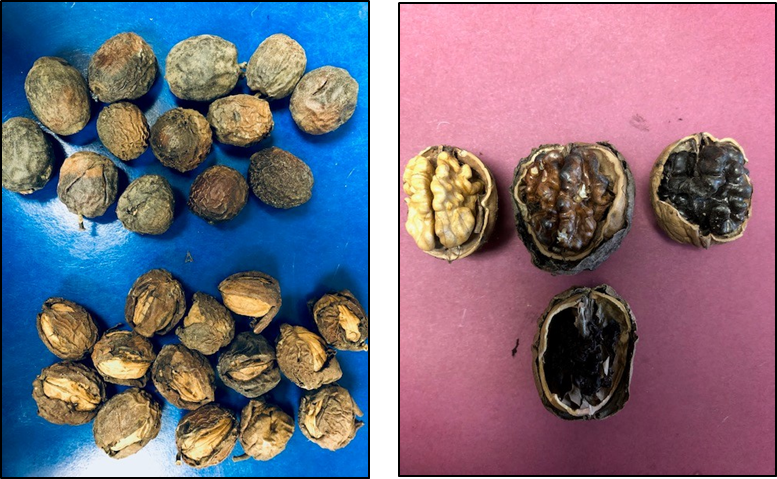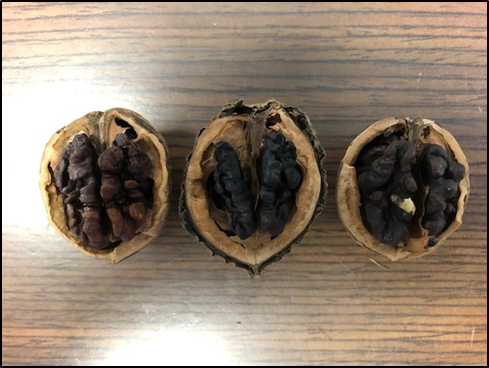Janine Hasey, UCCE Tree Crops Advisor Emerita, Sutter/ Yuba/ Colusa Counties
Dr. Themis Michailides, UC Davis Plant Pathologist at the Kearney Ag Research and Extension Center
Luke Milliron, UCCE Orchards Advisor Butte/ Glenn/ Tehama Counties
There are those years we like to leave behind, and 2022 will be at the top of the list for the walnut industry. We are still reeling from the 2022 harvest season with the large crop losses, extremely poor nut quality, and plunging prices. Using several sources of data, the focus of this article is on the most likely environmental conditions that led to 2022 crop damage and subsequent yield losses and poor nut quality. We will be emphasizing the crop loss and poor nut quality associated with the early September heat wave.
Weather events and records
There were three main weather-related events that contributed to 2022 crop loss – spring frost, excessive heat, especially in the late summer/early fall period, followed by rainfall mid-September shortly after the record heat. None are easy to assess in terms of quantifying crop loss in an orchard, but frost damage is easily observable (Photo 1). Nut damage sustained by the excessive heat is more complex, and it is very difficult to assess the potential related crop losses and total effect on reducing nut quality value, especially related to kernel color. The September rainfall likely contributed to the high mold incidence in 2022.
Table 1. Spring frost damage – minimum air temperature (oF):
| Date 2022 | Durham CIMIS weather station- Butte Co. | Verona CIMIS weather station- Sutter Co. |
| 4/12 | 29.2 | 30.3 |
Table 2. Excessive heat – maximum air temperature (oF) at three representative locations:
| Date 2022 | Durham CIMIS weather station | 1Verona CIMIS weather station | 2Sutter Co. AG Building station |
| 9/1 | 102.2 | 109.2* | 104.7 |
| 9/2 | 101.9 | 105.1 | 105.1 |
| 9/3 | 96.7 | 101.7 | 100.7 |
| 9/4 | 101.7 | 106.2* | 103.4 |
| 9/5 | 109.1* | 114.1** | 110.3 |
| 9/6 | 111.0** | 116.7** | 112.7 |
| 9/7 | 102.8* | 109.6* | 106.3 |
| 9/8 | 107.0* | 112.4* | 108.9 |
| 9/9 | 99.3 | 102.7 | 102.1 |
1Days >100 oF: June – 6 days, July – 7 days, August – 9 days
2Yuba City, CA
*Moderately out of range
**Far out of normal range
Table 3. September rainfall (inches)
| Date 2022 | Durham CIMIS weather station | Verona CIMIS weather station |
| 9/18 | 0.13 | 0.10 |
| 9/19 | 0.21 | 0.51 |
| 9/20 | 0.02 | 0.01 |
| 9/21 | 0.02 | 0.00 |
| 9/22 | 0.02 | 0.00 |
| 9/23 | 0.01 | 0.00 |
| 9/24 | 0.01 | 0.00 |
| 9/25 | 0.01 | 0.00 |
| Total | 0.46 | 0.62 |
Grower surveys of weather-related crop damage
In October, Sacramento Valley UCCE Advisors were in conversation with our local agricultural commissioner’s questioning if damage to quality was bad enough after the heat wave (Table 2) to declare an emergency. At that point, we had heard of problems with kernel color in the early varieties (not so unusual), and Chandler harvest was just underway. However, as Chandler harvest progressed, there were increasing reports of blackened Chandler nuts (black hulls, split and unsplit, stuck on the nutshell – see below). High nut losses were noted in the field, at the huller, and at the handler along with increasing mold incidence. Subsequently, some agricultural commissioners such as Lisa Herbert, Sutter County Agricultural Commissioner, sent grower surveys to assess weather related damage to the walnut crop. Several growers responded to her survey. Of these, almost half reported crop loss from the spring frost and all reported loss from excessive heat, citing sunburn damage, mold, loss of edible yield, and poor color grades. Still, the crop loss percentage reported in Sutter County did not rise to the 30 percent needed for a disaster declaration due to excessive heat.
Blackened hulls on walnuts
As the 2022 harvest progressed, many growers were reporting black nuts on their trees (Photo 2) and on the ground. Walnut hulls can turn black as nuts mature for several reasons including from diseases, insects, and physiological stresses. Plant pathologist Themis Michailides (UC Davis) examined many samples of black hulls on walnuts last fall finding the Chandler variety most affected. These nuts with the hulls dried on the shell (Photo 3) typically had black kernels that sometimes were shriveled (Photos 4 & 5).

Photo 3. Left. Top – nuts with mostly shriveled hulls before hull split; bottom – mostly shriveled hulls after hull split. Photo 4. Right. Kernels of nuts with black hulls were typically black and sometimes shriveled as in bottom nut. (Photos by T. Michailides)

Photo 5. Kernels of nuts with black hulls showing various degrees of shriveling. (Photo by T. Michailides)
Themis looked at temperature records and found there was a heat spike that preceded the hull damage. The very high daytime temperatures far out of the normal range that occurred in early September (Table 2), possibly coincided with the very early hull split stage for the Chandler variety. He believes that excessive heat likely caused a deterioration of the hull tissue, followed by secondary fungal (hull rot) invasion, and then mold. The high mold incidence was likely worsened by the rainfall following the heat wave (Table 3). This hull rot that essentially stopped the hull split process is the likely cause of black hulls at harvest, dark kernels, and subsequent high field, huller, and processor rejection levels. There is also a consensus that the excessive high early September heat caused a myriad of nut quality issues in early varieties like Tulare, causing darker kernels. The high heat occurred when the oil in the kernel was most susceptible to damage. Darker kernels have a shorter shelf life.
Statewide perspective – processor observations
Several walnut processors have commented that the percent of extra-light and light nuts was much lower than normal in most varieties in the 2022 crop. According to Eric Heidman of Diamond Foods, heat was a statewide issue, but the Sacramento Valley overall had hotter temperatures during the September heat wave than the San Joaquin Valley. The most severe mold was where the temperatures were hottest, specifically the southern Sacramento Valley. Their observation is corroborated with higher temperature spikes at the Verona CIMIS weather station in south Sutter County compared to the more northern Durham CIMIS weather station (Table 2). Diamond found about twice as much mold in nuts from the Sacramento Valley (~10%) versus the San Joaquin Valley (~4-5%) where no rainfall occurred in September. The mold was mainly found on kernels that were light amber or darker. Overall, edible yield was reduced 2 to 4 percentage points in most varieties, including Chandler. In addition to the nut losses many growers saw in the field and at the huller, Diamond estimates they will likely remove an additional 10-15% of the 2022 crop from the pool due to additional off grade, mold, and exceptionally dark color.
Summary
Many growers have the ability to mitigate damage from an April freeze event. Indeed, many growers with the system capability irrigated in the days before and/or actively during the freeze event and evaded damage. However, the heat and rain in September 2022 that are implicated as the cause of high crop losses and poor nut quality were out of grower control. As a grower, focus on what you can control. The California walnut industry must deliver quality. With the current economics of the walnut industry, take a hard look at considering removing those orchard blocks with older varieties that, even in a good year, often don’t have the highest quality. Check out the article Time for a Hard Look – Walnuts at the Sac Valley Orchard Source website. The crop loss and poor nut quality discussed in this article was associated with extreme events. To learn more about maximizing walnut quality under normal circumstances check out the article Maximizing walnut quality to improve value in a low-price year at the Sac Valley Orchard Source website.




Leave a Reply